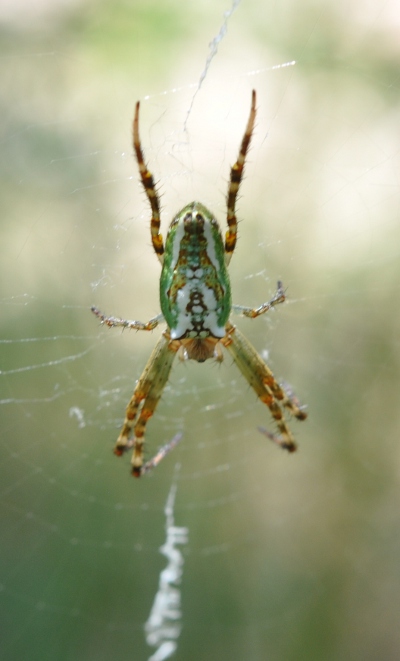Enamelled Spider
Category: Arachnida Spider

Facts about Enamelled Spiders, "Scientific name for Enamelled Spider is Araneus bradleyi". The enamelled Spider is an Australian spider belonging to the family Araneidae. It is mostly found in New South wales, Queensland, Victoria and Tasmania regions.
DESCRIPTION, BEHAVIOR AND HABITAT.
The Enamelled Spider has an enamelled appearance that varies from region to region although different forms may appear in a region, for instance, three color variations occurs in the Hobart area. Some enamelled spiders are pure green in color while others have both green and yellow colors.
The male Enamelled Spider are usually (8-9 mm) long while the females are (14-18 mm) long. The eggs are (1 mm) in diameter. The egg sac is round, flat bottomed and is covered with a red-brown silk that appears wooly. The eggs are always covered by a protective sticky mass.
The muscles in a Enamelled Spiders legs pull them inward, but the spider can't extend its legs outward. It will pump a watery liquid into its legs that pushes them out. A Enamelled Spider’s legs and body are covered with lots of hair and these hairs are water-repellent, which trap a thin layer of air around the body so the Enamelled Spiders body doesn't get wet. It allows them to float, this is how some spiders can survive under water for hours. A Enamelled Spider feels its prey with chemo sensitive hairs on its legs and than feels if the prey is edible. The leg hair picks up smells and vibrations from the air. There are at minimum, two small claws that are at the end of the legs. Each Enamelled Spiders leg has six joints, giving the spider 48 leg joints. The Enamelled Spider’s body has oil on it, so the spider doesn't stick to it’s own web.
The Enamelled Spider is active on its net only at night where it hunts by waiting for flying insects to get caught in their sloping orb web. It is a general predator that will feed on any flying insect that may fall in its web. This web is usually placed a meter above the ground. The Enamelled Spider completely eats the web in the morning and retreats to the surrounding vegetation during the day.
There is no known toxicity associated with these spiders they are considered harmless to human beings.
SCIENTIFIC CLASSIFICATION.
The spider belongs to the Animalia kingdom, a kingdom consisting of all animals. It is further classified in the phylum Anthropoda, because it possesses an exoskeleton, jointed appendages and has a segmented body. It belongs to class Arachnida due to the fact that it is eight legged. It is in order Aranae, the order of all spiders. It is in suborder Araneomorphae, family Araneidae, genius Araneus and species bradleyi.
Its binomial name is therefore Araneus bradleyi (Keyserling, 1888). Some scientists also refers to the enamelled spider as Epeira bradleyi.
Enamelled Spiders have oversize brains.
In the Enamelled Spider the oxygen is bound to "hemocyanin" a copper-based protein that turns their blood blue, a molecule that contains copper rather than iron. Iron-based hemoglobin in red blood cells turns the blood red
Enamelled Spiders have two body parts, the front part of the body is called the Cephalothorax-(the thorax and fused head of spiders). Also on this part of the body is the Enamelled Spider’s gland that makes the poison and the stomach, fangs, mouth, legs, eyes and brain. Enamelled Spiders also have these tiny little leg-type things called (pedipalps) that are next to the fangs. They are used to hold food while the spider bites it. The next part of the Enamelled Spiders body is the abdomen and the abdomens back end is where there is the spinnerets and where the silk producing glands are located.
A Enamelled Spiders stomach can only take liquids, so a Enamelled Spider needs to liquefy their food before they eat. They bite on their prey and empty its stomach liquids into the pray which turns it into a soup for them to drink.
A male Enamelled Spider has two appendages called "pedipalps" a sensory organ, instead of a penis, which is filled with sperm and insert by the male into the female Enamelled Spider’s reproductive opening.
Enamelled Spiders do not have a skeletons. They have a hard outer shell called an exoskeleton-(a rigid external covering for the body in some invertebrate animals). The exoskeleton is hard, so it can’t grow with the spider. The young Enamelled Spiders need to shed their exoskeleton. The Enamelled Spider has to climb out of the old shell through the cephalothorax. Once out, they must spread themselves out before the new exoskeleton will harden. Know they have some room to grow. They stop growing once they fill this shell. Female Enamelled Spiders are usually bigger than males.
Female Enamelled Spiders lay eggs on a bed of silk, which she creates right after mating. Once the female Enamelled Spider lays her eggs, she will than cover them with more silk.

 Back To Category Arachnida Spider
Back To Category Arachnida Spider